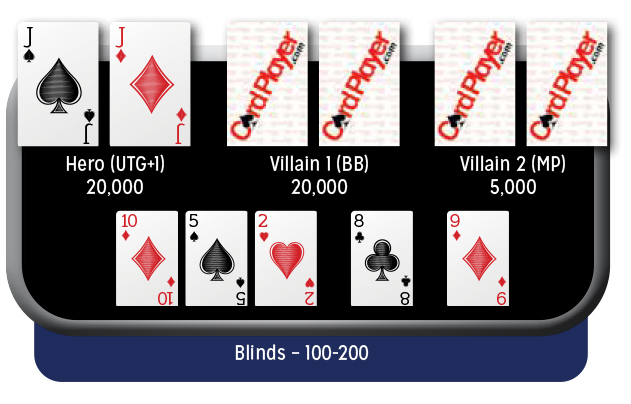






Poker Strategy With Jonathan Little: Getting Value With An Overpair In A Multi-Way PotDevelop Your Poker Skills And Learn How To Crush Games At PokerCoaching.com/CardPlayer |
|
|

Jonathan Little
Today I would like to share with you a hand I played in a $3,000 buy-in event during last year’s WSOP.
With blinds of 100-200, I raised to 500 out of my 20,000 stack from early position with pocket jacks. A tight, aggressive kid, who was down to 5,000 chips due to recently losing a big pot with K-K to Q-Q all-in preflop, called from middle position, and a loose, splashy player with 20,000 called from the big blind.
The flop came 10 5
5 2
2 and the big blind checked.
and the big blind checked.
While you should be very inclined to check when out of position in multi-way pots, it is fine to bet with your hands that are almost certainly best but vulnerable to being outdrawn, like your worst overpairs.
Many players bet large in this situation hoping to ensure they do not get outdrawn, but a much better play is to bet on the smaller side, roughly 700 into the 1,600 pot, in order to keep your opponents in with a wide range of junky hands that you crush.

Notice that if the opponents fold hands like 5-4, they are correctly folding to the large bet, meaning they are playing well. By making a smaller bet that can be reasonably called by numerous inferior hands, I extract value and allow my opponents to make errors. Remember, you want to induce your opponents to play poorly.
I bet 700 into the 1,600 pot. Only the tight, aggressive kid on the short stack called.
The turn was the 8 .
.
It is vitally important that you pay attention to the effective stack size when determining how much to bet, which is currently 3,775 with the pot being 3,075. In this situation, I want to size my bet such that I can go all-in on the river for less than the size of the pot while at the same time not making my opponent feel “obviously committed” on the turn.
If I bet 2,300 into the 3,075 pot, my opponent would only have 1,475 remaining in his stack going to the river. This would likely induce him to fold many hands that I crush on the turn, meaning I am not getting value.
If I bet 600 into the 3,075 pot, my opponent would have 3,175 in his stack going to the river with a 4,275 pot. While that is a nice stack-to-pot ratio going to the river, my opponent’s turn call would be profitable with almost any two cards, even if he is drawing thin, due to his amazing pot odds. If I bet 600 on the turn, he would only need to win 14% of the time to profitably call.
Instead, I bet 1,100 out of my opponent’s 3,775 stack into the 3,075 pot and my opponent called.
The river was the 9 .
.
 Now I decided to go all-in for my opponent’s entire 2,675 stack into the 5,275 pot, thinking he would call with many made hands that I beat.
Now I decided to go all-in for my opponent’s entire 2,675 stack into the 5,275 pot, thinking he would call with many made hands that I beat.
Looking back at this hand, I do not like my river bet. I lose to all slowplayed hands as well as pocket eights and stubborn pocket nines. My opponent may not call an all-in with bluff catchers like Q-10, thinking I must have a better hand to value bet on all three streets. It is also quite difficult for me to come up with many hands that I beat except A-10, K-10, Q-10, and J-10 (which I block).
While I do not love either of my options on the river, I think checking, hoping my opponent either turns a hand like A-Q or 7-7 into a bluff or value bets thinly with a hand like Q-10, is ideal.
After about four minutes of thought, my opponent folded what was presumably one of the marginal bluff catchers I was hoping to get value from. ♠
 Jonathan Little is a two-time WPT champion with more than $7 million in live tournament earnings, best-selling author of 15 educational poker books, and 2019 GPI Poker Personality of the Year. If you want to increase your poker skills and learn to crush the games, check out his training site at PokerCoaching.com/cardplayer.
Jonathan Little is a two-time WPT champion with more than $7 million in live tournament earnings, best-selling author of 15 educational poker books, and 2019 GPI Poker Personality of the Year. If you want to increase your poker skills and learn to crush the games, check out his training site at PokerCoaching.com/cardplayer.
